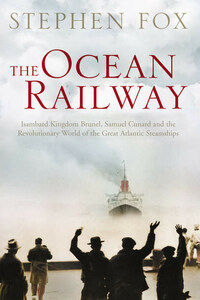From Liverpool, on the River Mersey, a ship bound for a port in the northeastern United States heads west eighty miles across the Irish Sea, and then – when clear of Holyhead – turns sharply south into St George’s Channel. The ship navigates carefully through St George’s, which funnels currents and storms from larger contiguous seas into a narrowing, unpredictable passage squeezed between England and Ireland. She moves southwesterly along the Irish coast, skirting the Old Head of Kinsale and other jutting headlands, to reach (but avoid) Cape Clear and the Fastnet Rocks at the bottom of Ireland. To this point the ship has gone about 300 miles since departing from Liverpool. From Cape Clear the ocean stretches out unimpeded to the western horizon and far beyond. Starting there, the great circle route to America arcs across nearly 3000 miles of the North Atlantic: one of the most varied, troublesome ocean voyages in the world.
Over its entire course, the great circle route veers gradually southwards from fifty-three to forty degrees north latitude. Giant spirals of wind and weather gust far above and perpendicular to the ocean’s surface, rotating across twenty or more degrees of latitude in counterclockwise systems that generally hit the great circle to America in the southern half of their spins. Prevailing winds in that stretch of ocean therefore come from the west and southwest, fighting any westbound ship. The weather is typically unsettled, with odd, sudden shifts in temperature, pressure, wind speed and direction. Systems collide and combine and bouncearound. Long, high, stately deepwater waves march along over hundreds of miles of ocean. On occasion, several wave components may converge momentarily, producing a rogue wave much bigger than any of its parts – up to four times the height of an average North Atlantic wave, sometimes even 100 feet high or more.
The weather, seldom agreeable, turns worse in winter. From October to March, the days are cold, short and dark, the sun low in the sky, the sea a turbulent dark grey. At mid-ocean, abrupt winter gales may quickly reach speeds of sixty-five knots, with steep waves of 40 to 60 feet and smaller combers curling out in extended cycles up to 400 feet from crest to crest. White flecks – from spindrift and foam atop the breaking waves – stand out in sharp relief against the slates of sea and sky: the natural world pared down to stark monochromes of grey and white, pretty but indifferent in its muted danger.
Towards the end of the voyage, well over 2000 miles from Liverpool – just as crews may be growing tired and irritable, with flagging attention and potential lapses in discipline, and passengers bored or restive, and food or fuel perhaps running low – the ship enters the notorious graveyard of the North Atlantic. This most hazardous sector of the great circle is encountered precisely when the ship’s company may already be stretched tight and vulnerable.
Here the winter gale season yields, with no relief, to iceberg season, which generally starts in January and then peaks from April to July. Far to the north, in the west of Greenland, glaciers flow down the coastal mountains to the sea, annually calving thousands of icebergs into the Davis Strait. The bergs float slowly southwards in the Labrador Current. At unpredictable times in the following year, the surviving remnants – about four hundred icebergs each season – reach the shipping lanes off Newfoundland. A typical splinter or castle berg weighs over 100,000 tons and stands about 150 feet high by 300 feet long, above water; in extraordinary cases both dimensions may be doubled and more. Smaller bergs, growlers, field ice and floes can pose more hidden danger to ships: lower in profile, sometimes barely above the ocean surface, they are harder to see and avoid. When a ship enters the iceberg zone, temperatures dip and the air smells different, and lookouts get edgy.








